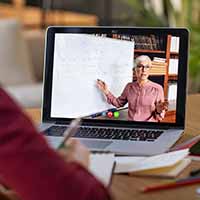Educational Technologies for Students, Teachers, and Administrators in 2022
Technology has been a part of education for as long as teachers have been teaching, but it has advanced a long way from notebook paper on a projector screen. Today’s educational technology uses projectors but it might be to project a touchable “screen” onto the wall. Nearly everything that students do in class has a technological element. They may access their coursework and turn assignments in online, even if they are meeting in class in person. They may use Zoom to meet in small groups, even if they are turning in their own separate work on paper.
Now that teachers and students are two years into increased online learning forced by the Covid-19 pandemic, technology in education is advancing in some exciting ways. The federal Office of Educational Technology has set as its priorities increased access to broadband for more students. Additionally, they have created the Education Blockchain Action Network that wants to use blockchain technology for secure, traceable, and verifiable exchange of educational data among institutions.
Additionally, and perhaps unsurprisingly, they are focused on equity. Technology can narrow the equity gap, but it can also make it wider if the technology itself isn’t easily accessed and understood. These challenges and more will surely be addressed in the coming months and years, but for now, technology in education is more advanced than ever. Following is a guide to the latest educational technologies in 2022.
Platforms, Applications, and Software
EdApp
EdApp is among the top mobile learning platforms. It is used around the world by millions of people for professional training development. The microlearning site provides free access to courses with about 50,000 lessons taken every day.
Learners can use EdApp on personalized profiles and instructors can use EdApp to create unlimited lessons, deploy to unlimited learners, and access a suite of analytical and management tools to track the learners’ progress.
While traditional learning means sitting at a desk and listening to lectures, microlearning embraces effective learning through absorbing short pieces of content. Often, microlearning segments are between five and ten minutes, which makes these focused learning objectives accessible to people during breaks and for repetitive listening.
WizIQ
WizIQ is an LMS platform that allows teachers to create customized online courses for interactive learning experiences. When students need personal instruction, WizIQ offers digital tutoring software on specific subjects.
For higher education, WizIQ offers test prep, with a digital whiteboard for online teaching and the ability to create many different types of tests. WizIQ combines instruction, collaboration, assessment, progress tracking certificates, and feedback into a single workflow. Collaboration can be assured via web conferencing, live public and private text chats, and discussion forums.
edX
edX was created by Harvard and MIT to deliver MOOCs, otherwise known as massive open online courses. MOOCs are online courses available for anyone to enroll. edX hosts specialized higher education courses for the university level, with many available for free.
edX also conducts research into learning based on how people interact with the platform. Although it was created by Harvard and MIT graduates, edX hosts courses from different universities. It does have a focus on natural sciences rather than humanities and arts. While EdApp embraces microlearning, edX’s approach is a more traditional lecture- and essay-based.
Coursera
Coursera is not new to the field, having been founded in 2012 by Stanford University computer science professors Andrew Ng and Daphne Koller. Like edX, Coursera provides MOOCs to universities and other organizations in a variety of subjects.
According to CNBC, in 2021 about 150 universities offered more than 4,000 courses through Coursera.
Blackboard Learn
BlackBoard Learn is an important tool for being able to store and share materials in the cloud. It’s mobile-friendly and enables students to attend classes anywhere. Blackboard enables collaboration through features built into the web browser that allow for online events such as instructional labs with HD video and audio. Chat features, screenshare, and a raise hand element permit students to request attention no matter where they are physically.
Thinkific
Thinkific offers a variety of templates and graphics that can enhance course design for college instructors and online educators. A monthly subscription plan is required, but that provides a wide range of features: live, on-demand, or blended classes; quizzes, surveys, assignments, and exams; progress tracking certificates; and creation of groups to foster engagement.
Equipment and Hardware
The technology shaping today’s classrooms unites students no matter where they are, whether they are physically in class, at home learning through a hybrid model, or working 100 percent remotely.
Teachers require cameras, digital textbooks, smartboards, and other digital elements to provide dynamic learning environments. But not only does technology need to provide learning in various formats, it also needs to connect students so they can learn from interacting with each other. The best educational technology equipment available today for today’s classrooms does just that.
Conference Cameras
Video calling continues to be a huge part of higher education. Whether it’s meetings with remote coworkers or students who can’t come to in-person office hours, instructors need cameras that can do more than look straight ahead.
Robust conference cameras feature an adjustable field of view—users can switch between 65, 78 or 90 degrees to show more or less of the user’s background environment. Also useful is a zoom feature to be able to show detail on papers, materials, or other subject matter.
For those instructors who prefer to write notes on a physical surface, using a digital whiteboard with a camera focused on the whiteboard can make the learning environment seem in-class even if students are learning at a distance.
Digital Whiteboards
Digital whiteboards take the projector to the next level. They allow instructors to sketch out ideas, write notes on, and share the results with the class. Physical whiteboards have width and height restrictions, but often digital whiteboards do not. A digital whiteboard that connects with other cloud apps could allow comments by viewers or collaborators.
The best digital whiteboards for today’s remote classrooms allow instructors to attach files, links, and images to the whiteboard. For many instructors who are used to writing on a traditional blackboard, the whiteboard may be the heart of the lesson. If so, it needs to be sharable with any students who are not physically in the room. And, it should be accessible on mobile devices.
Video Conferencing Monitors
Essentially, video conferencing monitors enable remote meetings. According to Statista (2022), Zoom had more than 300 million meeting participants per day in 2020. A monitor in the largest size possible will allow for viewing multiple screens at the same time without seeming cramped. A built-in camera that is located just above the screen ensures you are perfectly framed and helps create the feeling of eye contact while looking at your display.

